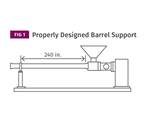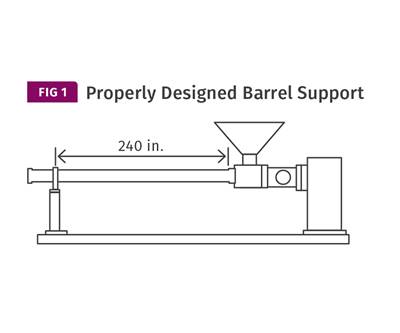Extrusion: The Facts About Barrel-Temperature Override
Cooling the barrel more may extract heat from the barrel, but not necessarily from the process. Here’s why.
Zone override is a common concern of almost every extrusion operator, and the typical response is to impose more cooling on the offending barrel zone—even including chilled water. That may or may not work in favor of the process. All zone override is telling you is that the polymer at the inside of the barrel wall is at a higher temperature than the barrel setting. Since the barrel is a very good conductor of heat—and the polymer is a very poor conductor—it’s logical that some of the shear heating near the barrel wall would be absorbed into the barrel. If the barrel settings are well below the internal melt temperature, the barrel temperature rises above the setting and overrides. How readily one can change the melt temperature simply by changing the barrel settings seems to be where the misunderstanding occurs.
It’s generally difficult to overcome the effects of the screw and drive motor by reducing the barrel temperatures, because the drive power on extruders is typically four to 20 times the maximum barrel-cooling capacity, depending on the extruder size and type of cooling. The larger the extruder, the less effective barrel cooling becomes, since the mass of polymer in the screw increases exponentially with screw size compared with the barrel surface area available for cooling. Cooling will extract heat from the barrel but not necessarily from the process because of the low thermal conductivity of the polymer. In fact, overcooling can actually add to the viscous dissipation by cooling the polymer near the barrel wall, thereby requiring more torque.
Extruder drive torque is largely the resistance of the screw to rotation in the viscous polymer. The electrical energy used by the drive is converted to rotational force to turn the screw. The rotational force is then converted again to a rise in polymer temperature by shear heating. Energy input from the drive mostly ends up in the polymer. The greater the resistance to rotation, the higher the input torque requirement and the more heat entering the polymer. The viscosity of the melted polymer between the screw and the barrel determines the resistance to rotation and the resulting torque requirement, regardless of the amount of the solids in the screw. That explains why it’s harder to melt a 25 MI polymer than a 2 MI of the same polymer on the same screw. It’s harder to get energy into the polymer because of the lower torque requirement.
To illustrate another way, think of turning a solid cylinder inside a hollow tube with some lubricating oil in between. The torque to turn the cylinder (screw) is largely a function of the lubricating oil.
If you have a very low-viscosity lubricant, the torque requirement is low and the energy input is low. Excessively cooling the tube can increase the viscosity of the lubricant and increase the torque requirement. This becomes a “Catch 22” as the more heat extracted in the barrel cooling, the more viscous the film becomes, and the more energy the screw must put into the film to rotate the screw.
The overall result depends on the effect of temperature on the viscosity of that polymer and the effectiveness of the barrel cooling. For polymers whose viscosity is less strongly affected by temperature, it is easier to reduce the overall melt temperature to some degree with barrel cooling. The property that reflects the polymers’ viscosity response to temperature is called the consistency index. For a power-law fluid, which fits most polymers, the viscosity-thinning behavior is a function of its consistency (m), Power-law coefficient (n), and shear rate. It’s described by the Ostwald de Waele equation:
Viscosity (μ) = mγn-1
m = consistency
γ = shear rate
n = Power-law coefficient
The consistency index is determined by the intercept on a linear plot of shear rate and viscosity at 1 sec-1. As a result, it is not a fixed value and is dependent on the melt temperature, so it’s a value that's not available for everyday processing unless you have exten- sive rheology data to model it. However, it’s been proven helpful to simply note the separation between shear-rate/viscosity curves at different temperatures, which is an indication of the effect of temperature on viscosity. The consistency is related to the vertical location of the shear-rate/viscosity curve at a specific temperature.
For example, the curve in the graph (pictured in slide show at top) shows a change of 3000 poise with a change of 20° C, or 150 poise per °C. That would be a moderate degree of temperature sensitivity, and the resin would tend to maintain its viscosity with changing temperature and lend it to some degree of possibly effective barrel cooling of the melt. Of the 11 polymers I checked, the viscosity changes range from 10 poise per °C to 1080 poise per °C at equal shear rates.
Assuming you can arbitrarily pick zone settings to control the melt temperature, like you were using an oven, will sometimes result in no change or even a slight increase in the melt temperature. Use of shear-rate/viscosity curves at different temperatures can assist you in determining what effect barrel cooling may provide. As mentioned, it’s surprisingly difficult to change the melt temperature significantly with the barrel-cooling zones working against the overpowering effect of the screw and drive, due to the poor thermal conductivity of the polymer and the continuous shear heating that occurs in the flight clearance.
As a result, arbitrary barrel-zone temperature selection and/or overcooling can lead to problems like unstable operation, instability as the cooling switches on and off, high wear, poor melt homogeneity, and wasted energy. Energy consumption is particularly affected, because you are putting energy in with the drive and taking it out with the barrel cooling. It’s not unusual to find extruders using 20% more total power (heating and cooling) than necessary because of such conditions.
Finding the best barrel settings requires evaluation of each of these negative aspects of overcooling compared with the effects on melt temperature. For example, it’s not smart operating practice to use 20% more power in attempting to achieve a few degrees lower melt temperature. Comparing shear-rate/viscosity curves at different temperatures will be a guide in what to do with your barrel zones. For major changes in melt temperatures, the screw design is usually where the solution is found. For polymers with a high viscosity change with temperature, it's likely that override can only be solved with screw design.
ABOUT THE AUTHOR: Jim Frankland is a mechanical engineer who has been involved in all types of extrusion processing for more than 40 years. He is now president of Frankland Plastics Consulting, LLC. Contact jim.frankland@comcast.net or (724)651-9196.
Related Content
Troubleshooting Flow Surging in Single-Screw Extruders
Surging can cause lower production rates, higher scrap rates, material degradation and higher labor costs. Here is a guide to troubleshooting this problem.
Read MoreWhy Are There No 'Universal' Screws for All Polymers?
There’s a simple answer: Because all plastics are not the same.
Read MoreRoll Cooling: Understand the Three Heat-Transfer Processes
Designing cooling rolls is complex, tedious and requires a lot of inputs. Getting it wrong may have a dramatic impact on productivity.
Read MoreThe Importance of Barrel Heat and Melt Temperature
Barrel temperature may impact melting in the case of very small extruders running very slowly. Otherwise, melting is mainly the result of shear heating of the polymer.
Read MoreRead Next
Extrusion: The Importance of Proper Barrel Supports
Supports that allow the barrel to expand and contract easily will prevent alignment issues. Examine them periodically for proper operation, particularly if you’re experiencing excessive wear.
Read MoreFor PLASTICS' CEO Seaholm, NPE to Shine Light on Sustainability Successes
With advocacy, communication and sustainability as three main pillars, Seaholm leads a trade association to NPE that ‘is more active today than we have ever been.’
Read MoreSee Recyclers Close the Loop on Trade Show Production Scrap at NPE2024
A collaboration between show organizer PLASTICS, recycler CPR and size reduction experts WEIMA and Conair recovered and recycled all production scrap at NPE2024.
Read More
.jpg;width=70;height=70;mode=crop)





















